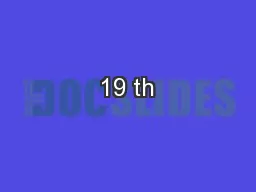

Century Apparel amp Production Objective 101 Apparel amp Textile Production I Summer 2014 1 In 1846 the first American patent was issued to Elias Howe for a process that used thread from two different sources ID: 175693
Download Presentation The PPT/PDF document "19 th" is the property of its rightful owner. Permission is granted to download and print the materials on this web site for personal, non-commercial use only, and to display it on your personal computer provided you do not modify the materials and that you retain all copyright notices contained in the materials. By downloading content from our website, you accept the terms of this agreement.
Slide1
19th Century
Apparel & Production Objective 1.01
Apparel & Textile Production I - Summer 2014
1Slide2
In 1846, the first American patent was issued to Elias Howe for "a process that used
thread from two different sources."
Elias Howe's machine had a needle with an eye at the point. The needle was pushed through the cloth and created a loop on the other side; a shuttle on a track then slipped the second thread through the loop, creating what is called the
lockstitch
.
Apparel & Textile Production I - Summer 2014
2
The Sewing Machine
Before the invention of the sewing machine people had to create garments by hand. Slide3
Apparel & Textile Production I - Summer 20143Sewing machines did not go into mass production until the 1850's, when
Isaac Singer built the first commercially successful machine.
Singer built the first sewing machine where the needle moved up and down rather than the side-to-side and the needle was powered by a foot treadle
.
Previous machines were all hand-cranked. However, Isaac Singer's machine used the same lockstitch that Howe had patented.
Elias Howe sued Isaac Singer for
patent infringement
and won in 1854.
Sewing Machine Continued… Slide4
Apparel & Textile Production I - Summer 20144
Sewing Machine Videos
Video 1
Sewing Machine Sewing MachineSlide5
Apparel & Textile Production I - Summer 20145
Ebenezer Butterick
- changed the face of home sewing forever
Created
the first graded (different sizes)
paper
pattern
.
The
company he founded continues to lead the way in make-it-yourself fashions 150 years later.
In the beginning, he only offered
men’s
and boys'
patterns.
In
1866
they began
offering women's dress patterns.
Paper PatternsSlide6
Apparel & Textile Production I - Summer 20146
Paper Pattern-
The
paper or cardboard template from which the parts of a garment are
traced
onto fabric before cutting out and assembling
Before Paper Patterns, people who sewed would lay out their fabrics and then
hand draw
the fabric cuts they wanted to made.
Ellen
Butterick, wife of Ebenezer, remarked to her husband how handy it would be if she had some sort of pattern to guide her in making her fabric
cuts.
A pattern
that was the correct size for her
son.
Thus
paper patterns were
born!
Slide7
Apparel & Textile Production I - Summer 20147
Charles Worth-
a fashion designer who is widely considered the
Father of Haute Couture
.
He is credited as the first designer to put
labels
onto the clothing he manufactured.
Worth's designs are notable for his use of lavish fabrics and trimmings, his incorporation of elements of historic dress, and his attention to fit.
Slide8
Apparel & Textile Production I - Summer 20148
Ready-to-Wear
; is the term for factory-made clothing, sold in finished condition, and in standardized sizes.
Also called
prêt-à-porter
.
Military uniforms
were the first ready-to-wear garments to be mass-produced during the War of 1812.
High-quality ready-to-wear garments for men became generally available soon thereafter.
Slide9
We Love Jeans!Apparel & Textile Production I - Summer 20149
Levi StraussSlide10
Levi Strauss was the inventor of the American blue jean!In 1997 the oldest pair of blue jeans was sold for $25,000.Blue jeans were originally called “Waist Overalls
”Jacob Davis added rivets to the blue jeans to help the pants from tearing.
Levi’s Blue Jeans were born on May 20, 1873The faded streaks on jeans are called
Whiskers
In
1954
the zipper was added to Levi’s.
Apparel & Textile Production I - Summer 2014
10Levi StraussSlide11
Apparel & Textile Production I - Summer 201411
Levi Srauss Videos/Articles
http://www.levistrauss.com/about/heritage
http://us.levi.com/shop/index.jsp?categoryId=18816896
http://
www.history.com/this-day-in-history/levi-strauss-and-jacob-davis-receive-patent-for-blue-jeans
https://
www.youtube.com/watch?v=orY4FVCy-vc
http://www.cbsnews.com/news/the-history-woven-into-denim-jeans/